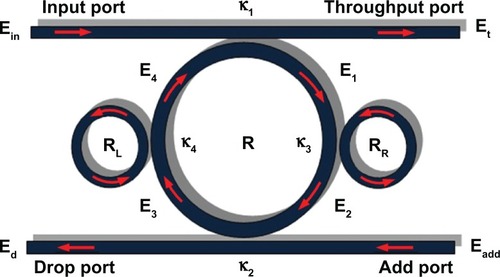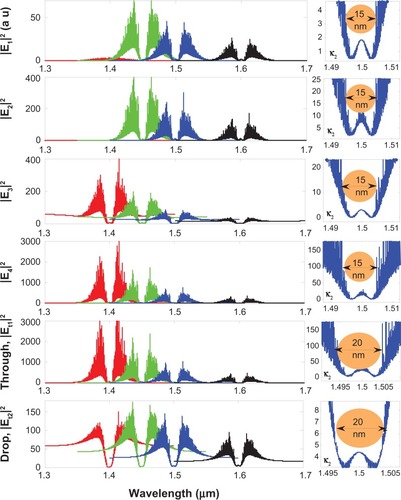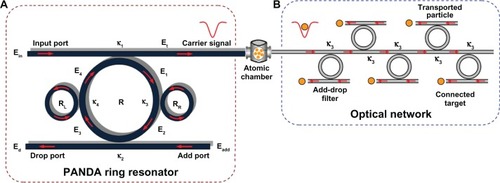 ?Mathematical formulae have been encoded as MathML and are displayed in this HTML version using MathJax in order to improve their display. Uncheck the box to turn MathJax off. This feature requires Javascript. Click on a formula to zoom.
?Mathematical formulae have been encoded as MathML and are displayed in this HTML version using MathJax in order to improve their display. Uncheck the box to turn MathJax off. This feature requires Javascript. Click on a formula to zoom.Abstract
A new optical trapping design to transport gold nanoparticles using a PANDA ring resonator system is proposed. Intense optical fields in the form of dark solitons controlled by Gaussian pulses are used to trap and transport nanoscopic volumes of matter to the desired destination via an optical waveguide. Theoretically, the gradient and scattering forces are responsible for this trapping phenomenon, where in practice such systems can be fabricated and a thin-film device formed on the specific artificial medical materials, for instance, an artificial bone. The dynamic behavior of the tweezers can be tuned by controlling the optical pulse input power and parameters of the ring resonator system. Different trap sizes can be generated to trap different gold nanoparticles sizes, which is useful for gold nanoparticle therapy. In this paper, we have shown the utility of gold nanoparticle trapping and delivery for therapy, which may be useful for cosmetic therapy and related applications.
Introduction
The interaction of nanoparticles with biological systems, ie, living cells, has become an attractive field of research in material science and biology. It holds the key for the advent of bionanotechnology, which is important for the interaction and manipulation of biological samples at the nanoscale. Gold nanoparticles are widely used for biological application and medical purposes due to their unique optical properties and electrochemical stability.Citation1–Citation3 The properties of gold nanoparticles are such that when light interacts with matter, the light is absorbed, scattered at the same frequency as the incoming light, reemitted, and any spectroscopic signals from the molecules at material surface is enhanced.Citation4 Further, the gold nanoparticle surface is facile. Specifically, various biomolecules can be conjugated to gold particles directly with surface functionalization,Citation5 and are nontoxic and nonimmunogenic.Citation6 Gold nanoparticles can also be used as a carrier for delivering molecules into cells.Citation7,Citation8 The trapping phenomenon of the gold nanoparticles occurs in the Rayleigh region,Citation9 in which the diameter of the sample is much smaller than the trapping beam wavelength.Citation10 The optical trapping mechanism arises from the fact that light exerts force when it interacts with matter and this phenomenon is known as optical tweezers.Citation11 This is an important technique with diverse applications in communications and biology. Recently, optical tweezers have been used widely to investigate the increment numbers in biochemical and biophysical processes,Citation12 cell interactions, cell manipulation without breaking the membrane, and to measure adhesion force between cells.Citation13–Citation15
The use of optical trapping tools within an add-drop multiplexer for microscopic volume trapping and delivery has been reported in both theoretical and experimental science.Citation16,Citation17 The carrier signal works in the same way as the optical tweezers interact with microparticles in a noninvasive manner. The phenomenon of static tweezers has been well analyzed, and the use of dynamic tweezers is an emerging field due to their wide applications.Citation18,Citation19 Schulzyz et al have demonstrated the transfer of trapped atoms between two optical potentialsCitation20 based on the principle that a highly focused laser beam exerts a gradient and scattering force that can be used to trap and move microscopic volumes of matter. In this paper, the PANDA ring resonator, an optical trapping tool, traps and transports molecules or atoms by using dark soliton pulses as input and Gaussian pulses to control the signal propagating within an add-drop optical multiplexer integrated with two nanorings on the left and right sides. The carrier signals in the form of optical vortices or potential well can be transported as dynamic optical tweezers. These are highly stable signals with no fluctuation over a certain period of time so that the atom or molecule does not disappear during the delivery process.Citation21 The desired dynamics of the optical tweezers can be achieved (by providing suitable input power and controlling the signals within the system), tuned, and stored within the ring resonator system before it reaches the desired destination via an optical waveguide. By using the proposed system, gold nanoparticles can be trapped, transported, and delivered. The proposed system can be used in biological and medical applications for diagnostic, therapeutics, imaging, and optical-sensing purposes.
Theory
The utility of optical tweezers are based on the force light exerts on a matter when it interacts with it. The basic principle in optical tweezers is that the momentum transfer is associated with bending light as the quanta of lightCitation22 carries energy proportional to its momentum and in the direction of propagation.Citation23 When light passes through an object, it refracts and changes direction.Citation24 This causes a change in the momentum of the light.Citation25 To conserve the total momentum, an object acquires momentum equal to that lost by the photons. This shows that a number of forces act on the object, which is known as radiation pressure (). The sum of forces can be split into two components, ie, the scattering force, in the direction of incident light and the gradient force, arises from the intensity gradient pointing towards the center of the beam.Citation26,Citation27 These two forces can be used to hold and move microscopic dielectric objects physically. In application, the radiation pressure from a focused laser beam is able to trap and manipulate microscopic objects as small as a single atom.Citation13
Figure 1 Basic principles of optical tweezers.
Note: A particle is trapped in the potential well formed by dark solitons at the center wavelength, λ0.
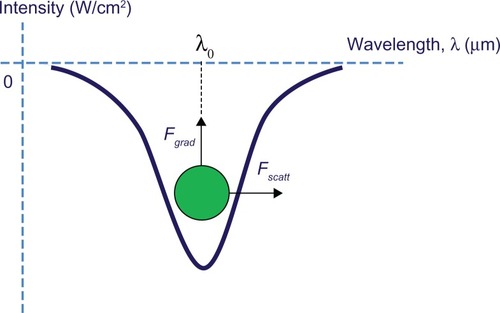
This trapping phenomenon can be categorized into two types as Rayleigh trapping and Mie trapping. If the size (d) of the trapped particle is much smaller than the wavelength of the trapping beam (d<<λ), such trapping is known as trapping in the Rayleigh regime. In this case, wave optics are required to explain the force acting on the particles. Particle can be considered as a miniscule dipole immersed in the optical trapping field oscillating at frequency ν. The two forces acting on the particles are known as dipole scattering and Lorentz force (gradient force). In Mie trapping, the size of the trapped particle is larger than the wavelength (d>>λ). In this case, the electric field is not uniform and geometrical optics are used to describe the forces acting on the system. In this paper, the Rayleigh trapping is described in detail because the gold nanoparticle diameters are much smaller than the wavelength of the carrier signals. The optical forces that act on the trapped particles can be defined as:Citation28
In this paper, dark soliton is used as a carrier and Gaussian pulse as a control signal propagating within the PANDA ring resonator. The potential well is formed between the gaps produced by two forces to confine atoms or molecules. The generated optical tweezer can propagate within the optical waveguide, thus trapped particles can be transported to the desired destination.Citation31 The dynamics of the optical tweezers are tuned and controlled by optimizing the parameters and input power of the system. EL and ER are the fields that propagate within the nanorings on the left and right hand sides of the add-drop filter. Ein and Eadd represent the input and control optical fields fed into the system.Citation21
Gold nanoparticles
Various force spectroscopy techniques are used to investigate nanoscopic systems, but optical tweezers are the most flexible because of their unique ability to precisely measure the three-dimensional motion of particles from small molecules to whole living cells. This technique provides fine control over a wide range of applied forces on the sample, which is important especially for biological specimens. In operation, the dark soliton as carrier signal is used to trap and store nanoparticles within the PANDA ring resonator system. Optical tweezers can propagate within optical waveguides, hence the micro- and nanoscopic volume (particles) can be transported from one point to another.Citation32,Citation33 In this paper, we propose the use of optical trapping tools for trapping, transporting, and delivering gold nanoparticles within optical waveguides. Gold nanoparticles can be used to probe a particular nanoscale system noninvasively. For the study of biological systems, it is customary to attach gold beads to the system of interest; the nanometer-scale motion and the forces acting on the bead can then be monitored. The gold nanoparticle size ranges from 5 to 100 nm, which is well synthesized and characterized.Citation8,Citation34 Gold nanoparticles can be trapped and transported within the proposed system.
Generally, gold particles are difficult to trap due to the strong scattering and absorption forces. For stable three-dimensional trapping, gradient forces must be stronger than the scattering and absorption forces acting on the particle. Small gold nanoparticles are more suitable for trapping and delivery. This is because scattering and absorption forces decrease faster than the gradient force with particle diameter.Citation35 The maximum force that could be exerted on the particles in the lateral direction was found using Stokes’ drag calibration. For particles ranging from 101 nm to 254 nm diameter, the maximum force was found to be in the range of 0.56 pN to 2.2 pN using a laser power of 135 mW (the larger the particle, the larger the maximum force). Thus, the maximum force can exert into the proposed system by using the full laser power of 7 W, which will be around 20 pN. Normally, 20 pN of force is sufficient enough to hold and manipulate cells or nanoparticles.Citation28,Citation33 The term opticution refers to the interaction between a very-high-flux laser light (107 W/cm2) and biological sample by breaking covalent bonds and causing photochemical reaction, this might cause cell damage or death.Citation36 In this research, the range of values will not cause opticution on the biological sample, thus it can be used in investigations of nanoscale systems where the force range is important. In simulation, dark soliton is generated at center wavelength 1.6 μm with peak power 5 w and pulse width 1.20 ns fed into the system via an input port. A Gaussian pulse as a control signal is introduced into the system via the add port. The radius of center, left, and right rings are 37 μm, 100 nm, and 100 nm, respectively (). The coupling coefficients of the PANDA ring resonator system are set to be κ1 = 0.16, κ2 = 0.66, κ3 = 0.10, and κ4 = 0.10. The effective core area of the center ring, Aeff, equals 4 μm2 while the effective core areas, Aeff, for the right and left side of the center ring (nanoring) are 1 μm2. The waveguide losses coefficient, α is 0.25 and coupling loss, γ is assumed to be 0.01.
Dynamic tweezers are generated at four different center wavelengths which are 1.4, 1.5, 1.6, and 1.7 μm (). The optical fields circulate within the center ring resonator. Et and Ed are output fields at the throughput and drop ports, respectively. The shape and peak power of the fields are different for each center wavelength used. Based on the generated results, tweezers with the center wavelength of 1.6 μm produce the highest intensities at the drop port (80 W). This shows that gold nanoparticles are stably trapped inside the potential well and can be transported by optical tweezers signals. The important aspect of this simulation is that the required dynamic behavior of the tweezers can be obtained by tuning some parameters of the system including add-port input signal, coupling coefficient, and ring radius. By controlling these parameters, the required number of gold nanoparticles can trapped and transported through throughput and drop ports, otherwise the signal will propagate within the ring before collapsing or decaying into the waveguide. The output of optical tweezers from throughput and drop ports with different ring radii was simulated (). Different sizes of trapping are generated, which allows the capture of different gold nanoparticle sizes. In application, the optical tweezers signals can propagate within an optical waveguide, thus demonstrating that the gold nanoparticle can be transported to the required destination by using the optical fiber. The proposed system uses trapping signals in the form of dark solitons that can be converted to bright solitons when passed through an add-drop filter with specific parameters, and the gold nanoparticles are safely retrieved by the receiver at drop port of the system ().Citation16,Citation32 In the proposed system, we used the spherical gold nanoparticle to conjugate molecular therapy which has excellent enhanced Raman scattering surface propertiesCitation37 and are known to be nontoxic and nonimmunogenic.Citation38 The gold particles can be trapped and transported via the suitable waveguide to the required targets or destinations, which can be useful for the applications such as atom bottom-up, drug delivery, cosmetics, and nanoelectronic devices.
Figure 3 Results of dynamic optical tweezers generated at four different center wavelengths, where E1, E2, E3, and E4 are circulated in optical fields within the center ring resonator shown in (A), (B), (C), and (D), respectively. Et and Ed are output optical fields generated at the throughput and drop ports of the PANDA ring as shown in (E) and (F), respectively.
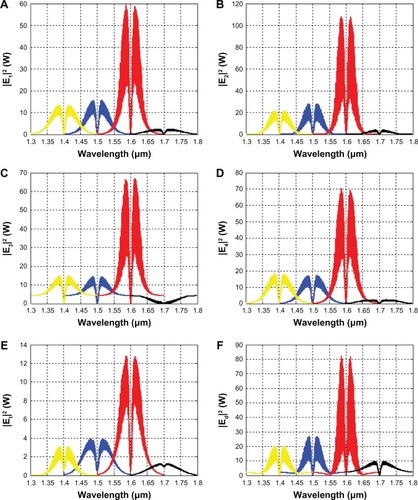
Conclusion
Our results show that gold nanoparticles can be trapped and transported via an optical waveguide by using dynamic optical tweezers generated from dark soliton as a carrier signal and Gaussian pulse as control signal. The dynamic behavior of the optical tweezers can be controlled by tuning the optical pulse input power and parameters of the PANDA ring resonator system. Nanorings on both sides of the resonator amplify the potential well and as a result the stability of the trapping signals increases. The use of a molecular buffer and resonator system to build the long-distance gold nanoparticle trapping and delivery can be realized by using the proposed system. The trapped gold nanoparticles can be transported via an optical waveguide to the required target, where users can retrieve the desired signal (messages). The problem of trapping atoms or molecules with different sizes can be solved by using tunable optical tweezers where the depths of the potential well can be adjusted to the required size. This tunable tweezing technique can be used primarily in nano-medicine applications such as drug trapping, delivery, storage (molecular buffer), and delivery via a quantum router with the addition of the PANDA ring resonator for amplification purposes, and blood cleaning in artificial kidney and human artificial hearts. Due to its smart structure (on-chip design), low cost, and long-lasting design, the proposed system is of great importance in the near future.
Acknowledgements
We would like to thank the Institute of Advanced Photonics Science, Nanotechnology Research Alliance, Universiti Teknologi Malaysia (UTM) and King Mongkut’s Institute of Technology (KMITL), Thailand for providing research facilities. This research work has been supported by UTM’s Tier 1/Flagship Research Grant, MyBrain15 Fellowship/MOHE SLAB Fellowship, and the Ministry of Higher Education (MOHE) research grant.
Disclosure
The authors declare no conflicts of interest in relation to this work.
References
- PellegrinoTSperlingRAAlivisatosAPParakWJGel electrophoresis of gold-DNA nanoconjugatesJ Biomed Biotech2007200726796
- YuMXZhouCLiuJBHankinsJDZhengJLuminescent gold nanoparticles with pH-dependent membrane adsorptionJ Am Chem Soc201113329110141101721714577
- YangAHMooreSDSchmidtBSKlugMLipsonMEricksonDOptical manipulation of nanoparticles and biomolecules in sub-wavelength slot waveguidesNature20094577225717519122638
- SperlingRARivera GilPZhangFZanellaMParakWJBiological applications of gold nanoparticlesChem Soc Rev20083791896190818762838
- HuangXJainPKEl-SayedIHEl-SayedMAGold nanoparticles: interesting optical properties and recent applications in cancer diagnostics and therapyNanomedicine (Lond)20072568169317976030
- HanGGhoshPRotelloVMMulti-functional gold nanoparticles for drug delivery bio-applications of nanoparticlesAdv Exp Med Biol2007620485618217334
- JainPKLeeKSEl-SayedIHEl-SayedMACalculated absorption and scattering properties of gold nanoparticles of different size, shape, and composition: Applications in biological imaging and biomedicineJ Phys Chem B2006110147238724816599493
- SeolYCarpenterAEPerkinsTTGold nanoparticles: enhanced optical trapping and sensitivity coupled with significant heatingOpt Lett200631162429243116880845
- SrinivasPPatraCRBhattacharyaSMukhopadhyayDCytotoxicity of naphthoquinones and their capacity to generate reactive oxygen species is quenched when conjugated with gold nanoparticlesInt J Nanomedicine201162113212222114475
- SvobodaKBlockSMOptical trapping of metallic Rayleigh particlesOpt Lett1994191393093219844491
- AshkinADziedzicJMBjorkholmJEChuSObservation of a single-beam gradient force optical trap for dielectric particlesOpt Lett198611528829019730608
- ChenLHeneinGLucianiVNanofabrication techniques for controlled drug-release devicesNanomedicine (Lond)2010611621182411
- AshkinADziedzicJMYamaneTOptical trapping and manipulation of single cells using infrared laser beamsNature198733061507697713320757
- ChenHDGeKKLiYMApplication of optical tweezers in the research of molecular interaction between lymphocyte function associated antigen-1 and its monoclonal antibodyCell Mol Immunol20074322122517601377
- SeegerSMonajembashiSHutterKJFuttermanGWolfrumJGreulichKOApplication of laser optical tweezers in immunology and molecular geneticsCytometry19911264975041684929
- PiyatamrongBKulsiriratKMitathaSYupapinPPDynamic potential well generation and control using double resonators incorporating in an add/drop filterMod Phys Lett B20102430713082
- CaiHPoonAWOptical manipulation and transport of microparticles on silicon nitride microring-resonator-based add-drop devicesOpt Lett201035172855285720808347
- EgashiraKTerasakiAKondowTPhoton-trap spectroscopy applied to molecules adsorbed on a solid surface: probing with a standing wave versus a propagating waveAppl Opt20104971151115720197812
- KachynskiAVKuzminANPudavarHEKaputaDSCartwrightANPrasadPNMeasurement of optical trapping forces by use of the two-photon-excited fluorescence of microspheresOpt Lett200328232288229014680158
- SchulzyzMCrepazHSchmidt-KalerFEschnerJBlattRTransfer of trapped atoms between two optical tweezer potentialsJ Modern Opt2007541116191626
- TeekaCJalilMAYupapinPPAliJNovel tunable dynamic tweezers using dark-bright soliton collision control in an optical add/drop filterIEEE Trans Nanobioscience20109425826221266312
- WuSPlissonTBrownRCPhillipsWDPortoJVMultiphoton magnetooptical trapPhys Rev Lett20091031717300319905754
- GrangeWHusaleSGuntherodtH-JHegnerMOptical tweezers system measuring the change in light momentum fluxRev Sci Instrum200273623082316
- MoffittJRChemlaYRIzhakyDBustamanteCDifferential detection of dual traps improves the spatial resolution of optical tweezersProc Natl Acad Sci U S A2006103249006901116751267
- SheetzMPWilsonLMatsudairaPLaser Tweezers in Cell BiologySan Diego, CAAcademic Press San Diego1997
- AshkinAForces of a single-beam gradient force on a dielectric sphere in the ray of optic regimeBiophys J1992612156958219431818
- AshkinASchutzeKDziedzicJMEuteneuerUSchliwaMForce generation of organelle transport measured in vivo by an infrared laser trapNature199034862993463482250707
- SvobodaKBlockSMBiological applications of optical forcesAnn Rev Biophy Biomol Struct199423247282
- BauerWRNadlerWMolecular transport through channels and pores: Effects of in-channel interactions and blockingProc Natl Acad Sci U S A200610331114461145116861303
- RosenberryMAReyesJPTupaDGayTJRadiation trapping in rubidium optical pumping at low buffer-gas pressuresPhys Rev A200775023401-16
- JalilMATasakornMSuwanpayakNAliJYupapinPPNanoscopic volume trapping and transportation using a PANDA ring resonator for drug deliveryIEEE Trans Nanobioscience201110210611221518667
- JalilMAPiyatamrongBMitathaSAliJYupapinPPMolecular transporter generation for quantum-molecular transmission via an optical transmission lineNano Communication Networks20101296101
- SuwanpayakNJalilMAAzizMSAliJYupapinPPMolecular buffer using a PANDA ring resonator for drug delivery useInt J Nanomedicine2011657558021674014
- HaissWThanhNTKAveyardJFernigDGDetermination of size and concentration of gold nanoparticles from UV-Vis spectraAnal Chem200779114215422117458937
- WangKSchonbrunECrozierKBPropulsion of gold nanoparticles with surface plasmon polaritons: evidence of enhanced optical force from near-field coupling between gold particle and gold filmNano Lett2009972623262919545160
- VolpeGPadgettMJMolloyJMcGloinDOptical tweezers: methods and applicationsContemporary Physics2011
- CaiWGaoTHongHSunJApplications of gold nanoparticles in cancer nanotechnologyInt J Nanomedicine200811732
- BrownSDNativoPSmithJ-AGold nanoparticles for the improved anticancer drug delivery of the active component of oxaliplatinJ Am Chem Soc2010132134678468420225865
